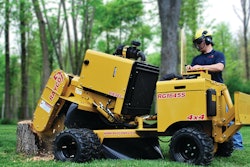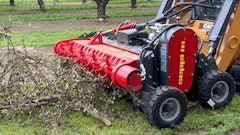
There are basically two kinds of professional tree care contractors: those who make tree care their primary business, and those who provide a limited array of services to supplement an overall landscape maintenance offering.
Scott Moran of Creative Landscapes in Cambridge, WI (on the cover), is an example of the latter. Creative Landscapes actually specializes in landscape design/installation, hardscaping and outdoor kitchens, while also offering turf fertilization, seeding and aeration services. But the company also offers light tree trimming, primarily in conjunction with its spring and fall cleanups. “If we can get it from the ground, we’ll get it,” Moran says, while also pointing out that neither he nor his crews do any climbing or aerial lift work. Creative Landscapes operates a variety of chainsaws, and both manual and gas-powered pole pruners.
At the other end of the spectrum is Larry Brown, a certified arborist and the owner of All Year Round Tree & Landscape Management in Phoenix, AZ. Brown founded his company in 1984 as All Year Round Tree Care. In the past year, though, he’s partnered with friends Matthew Johnson and James Werner to create a landscape management division. Tree services still generate the lion’s share of the company’s revenue, “but landscape management is really coming on strong,” Brown points out.
“We do pretty much any and all tree work,” Brown goes onto say. “We do trimming and pruning, fertilizing, and tree and stump removal.”
Hard-core tree care contractors in other parts of the country also provide services to help prevent and/or manage different types of disease and invasive pests, such as emerald ash borer (EAB) which has permeated throughout the northeastern quadrant of the country and is even spreading further west into Kansas. A variety of specialty tools and products are available to assist contractors in this regard.
For the landscape contractor who is simply looking to branch into basic tree care services, the following equipment is essential: chainsaws, pole pruners, chippers and stump removers. Brown offers advice on what to look for when shopping for each of these key pieces of tree care equipment.
Chainsaws and pole pruners
The majority of All Year Round’s tree work is pruning, which is very labor-intensive. “The main thing we’re looking for with chainsaws is balance,” Brown says. “Our tree climbers must be able to safely one-hand the saw and reach out and cut limbs. I like to pick a model with the best power-to-weight ratio. We need saws that are fast and have good balance.” Brown says the Stihl MS 201 T is his favorite.
Brown also favors Stihl's powered pole pruners, which he purchases from dealer Bingham Equipment in Phoenix. Again, balance is the main issue. “We want a lighter-weight pruner with as long a reach as possible,” Brown says. Also, ask your equipment dealer to explain how the power is transferred from the engine to the saw bar. Brown says he’s used different models in the past that caused major headaches in this area.
Chippers
Brown favors Vermeer chippers primarily because of their feeding systems and safety features. He has both a BC1500 and BC1000XL. “One thing I really like about the 1000 is that fact that it has gone back to a belt-drive system,” Brown says. “When you drop the handle, it engages the belt for the drive. Most chippers have a clutch. But if you don’t keep it adjusted all the time, considering the abuse a chipper goes through, it will burn up clutches. With a belt-drive system, the worst that can happen is you burn up a belt. But when you burn up a clutch, and maybe melt some of the components around it, you could have a $1,500 repair bill on your hands.” Brown knows, because it happened to him.
Stump removers
Brown likes the Dosko brand. “I tend to go for the more ‘manual’ models where you move the stump grinder back and forth and up and down yourself. I have two models, a larger one we only using sparingly for really big jobs, and a smaller one that can go in the bed of a truck. Portability is really important."
Also for stump grinders, you should look at weight and size (since you'll likely be working on existing turf and in close quarters from time to time), cutting depth and, of course, horsepower.
Additionally, Brown and his crews us Corona bypass pruners and loppers. This covers the most essential tree care equipment a contractor will invest in. But for the true pros like Larry Brown, there’s one more item to mention. “A lot of tree companies don’t do a very good job cleaning up,” Brown says. “We want to do an impeccable job, so the biggest, most powerful backpack blower is a must. We use Stihl BR 600s.”




![Doosan Bobcat Wacker Neuson Stack 2ec Js Pb V6e[1]](https://img.greenindustrypros.com/mindful/acbm/workspaces/default/uploads/2025/12/doosan-bobcat-wacker-neuson-stack2ecjspbv6e1.CPyyz8ubHn.png?auto=format%2Ccompress&bg=fff&fill-color=fff&fit=fill&h=100&q=70&w=100)







![Doosan Bobcat Wacker Neuson Stack 2ec Js Pb V6e[1]](https://img.greenindustrypros.com/mindful/acbm/workspaces/default/uploads/2025/12/doosan-bobcat-wacker-neuson-stack2ecjspbv6e1.CPyyz8ubHn.png?ar=16%3A9&auto=format%2Ccompress&bg=fff&fill-color=fff&fit=fill&h=135&q=70&w=240)




![T708 2025 Ga Tl11 R3 Hr [1 Q5 A1066]](https://img.greenindustrypros.com/mindful/acbm/workspaces/default/uploads/2025/10/t708-2025-ga-tl11r3-hr-1q5a1066.KcuUhTiF78.jpg?ar=16%3A9&auto=format%2Ccompress&fit=crop&h=135&q=70&w=240)

